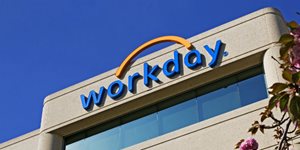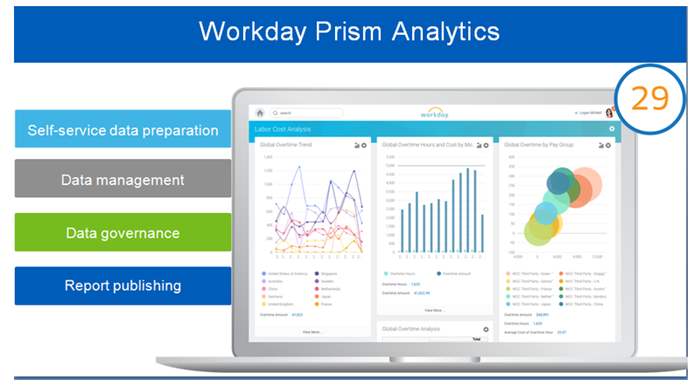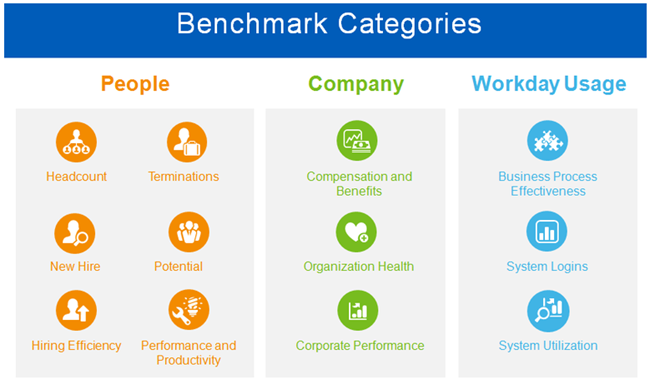Workday's First DaaS Offering Benchmarking is Explained
Like most providers of SaaS solutions, Workday, a finance and human resources cloud  applications provider, has been on the lookout for new ways of enabling businesses to fully understand the industry-wide issues as well as the issues that are specific to the company through leveraging Big Data. With this goal in mind, in July 2016, Workday purchased a venture-backed analytics provider called Platfora Inc. that provides Apache Spark-powered business intelligence software. Following that acquisition, Mike Frandsen, Workday’s executive vice president of products, support, and delivery, dribbled out some tidbits to convey a message that Platfora’s technology wouldn’t be a bolt on for Workday’s solution, instead, a new application will be built on one technology foundation, resulting in just a single version of Workday. After introducing the integration plan last year at its annual conference, Workday Rising and spending much of the year integrating Platfora to bring more data into Workday, this year at Workday Rising, the vendor announced the general availability of its Data-as-a-Service (DaaS), a cloud service that provides data to customers to enable more informed decision-making. Its first DaaS offering, Workday Benchmarking was also rolled out during the event.
applications provider, has been on the lookout for new ways of enabling businesses to fully understand the industry-wide issues as well as the issues that are specific to the company through leveraging Big Data. With this goal in mind, in July 2016, Workday purchased a venture-backed analytics provider called Platfora Inc. that provides Apache Spark-powered business intelligence software. Following that acquisition, Mike Frandsen, Workday’s executive vice president of products, support, and delivery, dribbled out some tidbits to convey a message that Platfora’s technology wouldn’t be a bolt on for Workday’s solution, instead, a new application will be built on one technology foundation, resulting in just a single version of Workday. After introducing the integration plan last year at its annual conference, Workday Rising and spending much of the year integrating Platfora to bring more data into Workday, this year at Workday Rising, the vendor announced the general availability of its Data-as-a-Service (DaaS), a cloud service that provides data to customers to enable more informed decision-making. Its first DaaS offering, Workday Benchmarking was also rolled out during the event.
“Water, Water, Everywhere, nor Any Drop to Drink”
Pete Schlampp, vice president of Workday Analytics, Workday, explained the motivation behind  all these efforts by using a great analogy: “We’re living at a time when we’re awash in data, but short on ways to quickly turn that data into information we can act on with confidence. Much like the sailor in the classic Samuel Taylor Coleridge poem who laments, “Water, water, everywhere, nor any drop to drink,” the problem isn’t the quantity of data. The problem is that it’s not easily consumable. Data, like water, is everywhere, but helping you channel that data into actionable insight—rather than drowning in the deluge.” Another problem he also pointed out is the fact that although it is sometimes possible to get actionable insights, too often, it is difficult to leverage it in a timely fashion.
all these efforts by using a great analogy: “We’re living at a time when we’re awash in data, but short on ways to quickly turn that data into information we can act on with confidence. Much like the sailor in the classic Samuel Taylor Coleridge poem who laments, “Water, water, everywhere, nor any drop to drink,” the problem isn’t the quantity of data. The problem is that it’s not easily consumable. Data, like water, is everywhere, but helping you channel that data into actionable insight—rather than drowning in the deluge.” Another problem he also pointed out is the fact that although it is sometimes possible to get actionable insights, too often, it is difficult to leverage it in a timely fashion.
Yet, the promise of the data-driven business model remains remarkably vexing, it requires a technology that can easily make connections between the dots and translate customer insights into business outcomes. Therefore, Workday Prism Analytics has been designed to analyze the data stored in external data sources alongside Workday SaaS applications through leveraging the power of the open REST application programming interfaces (APIs). That way, the vendor aims to put a richer insight into a company’s employee and financial health into decision-makers’ hand. Since the platform was designed based on the acquisition of Platfora which was known for its data integration and transformation capabilities, Workday analytics can work seamlessly with other tools as well. Even though the company didn’t reveal pricing details, Workday Prism Analytics will be marketed as a separately priced Workday component.

With all due respect, does it sound to you as if all the vendors are echoing each other when it comes to advanced analytics “innovation”? If so, Workday claims their approach to keeping their core capabilities around a single architecture is what differentiates them from the likes of Salesforce, SAP, and Oracle, meaning that the vendor provides the more holistic user experience. On top of that, the vendor’s differentiating point from the other big players betting on the similar capabilities is its first DaaS offering, Workday Benchmarking, as there is no vendor that offers benchmarking capabilities at this scale, according to the company.
Its First DaaS Offering: Workday Benchmarking
What does Workday Benchmarking do, then? As the name of the product implies, it is designed to provide organizations with a deeper insight that portrays businesses’ strengths and weaknesses, comparing to similar organizations. How does Workday Benchmarking gather the data, you may ask? There is a tradeoff. Once its customers opt-in to the service, they can select what data they’d like to contribute. From there, their data is added to a secure, aggregated data pool. In exchange, those customers will be given access to the vendor’s customer participating community where they can compare themselves against their peers with similar demographics, such as industry or company size. Considering we are getting closer to the General Data Protection Regulation (GDPR) deadline of May 25, 2018, I have started looking at all the announcements related to data in the lens of GDPR compliance. However, since participation is on an opt-in basis, at the very highest level, the service doesn’t seem to have an issue with European GDPR requirements.
It is worth noting that the Workday’s community consists of over 26 million workers across more than 1,800 global organizations. Receiving live data retrieved from such a sheer volume of participants could give an upper-hand to the businesses. The benchmarking service is being bundled into the base subscription at no additional cost.

To put this into perspective, here are some use cases that Workday shared:
-
Organizational Health - To better manage employee turnover, a technology CEO could view a dashboard on a tablet that combines regional attrition data from Workday HCM with third-party survey data on employee engagement globally.
-
Financial Forecasting - To align sales strategies with financial forecasting, a general manager of an insurance company could access reports that merge financial data in Workday with sales pipeline data, enabling her to understand current growth rates and how the opportunity backlog might impact future revenue.
-
Worker Productivity - To get a firm understanding on how worker overtime or absence impacts worker productivity, an HR leader at a manufacturing company could view a mobile dashboard on her smartphone that blends time off data from Workday HCM with shop floor output data from a supply chain system.
-
Revenue - When reporting on performance, a financial planning analyst at a retailer can drill into reports that combine finance data from Workday with data from a point-of-sale system to quickly analyze profitability by store, region, or product line.
What’s On the Pipeline?
While Benchmarks already includes the majority of the critical metrics such as workforce demographics, turnover and retention, leadership effectiveness and Workday usage, the vendor won’t rest on its laurels as financial benchmarks such as core revenue growth and return on invested capital are next to be added in the near future. As per the vendor claims, once financial benchmarks have been covered under this service, executives will be able to compare revenue per employee against similar organizations.
When it comes to the future direction of Workday Prism Analytics, built-in data discovery feature is in the making. The premise of the feature will be the ability to navigate data and develop visual reports.
My POV
First and foremost, it is also important to note that Workday isn’t eyeing the business intelligence (BI) space as the newly announced product is not a standalone offering. The point is that the vendor truly integrated Platfora’s technology in its core platform and the new capabilities are only available to those who already have Workday HCM and financials. This addition was a necessary step for the vendor as its customer have been long relying on third-party BI tools.
The efforts behind this product launch are also noteworthy as Workday teamed up with some of its large customers, such as Christiana Care, Hitachi, Shelter Mutual Insurance, Thomson Reuters, and United Technologies Corporation, to design an effective single console in Workday Prism Analytics. Prior to this collaboration, not only did the acquisition of Platfora contribute but also other acquisitions such as GridCraft and Upshot enabled Workday with a very robust set of integration capabilities.
As I mentioned earlier, it feels like all the cloud vendors are launching more or less the same capabilities. Although it is the fact, there are some nuances between their offerings as every vendor takes the matter into their own hands in their own unique focus depending on the vertical industries they serve the most. Therefore, Workday’s efforts on advanced analytics are still significant for those who are on the human capital and finance sides of the things.

Venus Tamturk
Venus is the Media Reporter for CMS-Connected, with one of her tasks to write thorough articles by creating the most up-to-date and engaging content using B2B digital marketing. She enjoys increasing brand equity and conversion through the strategic use of social media channels and integrated media marketing plans.